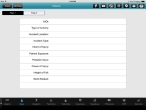Describe patient injuries
-
(If you have not done so already) Add a new incident, or open an existing incident, as described Add or edit an incident.
By default, the Scene tab appears.
-
At the bottom of the screen, touch Injury.
Fields for gathering information related to the patient's injuries appear.
-
Enter data as described in Understand the interface and data entry in it.
Field Information needed MOI
The circumstance in which an injury occurs.
If you touch MVC (motor vehicle crash), a new screen appears containing fields specific to this type of incident. Information on specifying data for these fields is available in Add motor vehicle crash (MVC) details.
Type of Activity
A description of the activity the patient was involved in when the injury occurred.
Incident
LocationA description of where the patient was when the injury was sustained.
Incident Type
An indication of whether or not the injury was work-related.
Intent of Injury
A description of the intent behind the injury (unintentional, assault, legal intervention, and so forth).
Patient Exposure
A list of items the patient was exposed to as causing the injury, or as a result of the injury, such as blood, chemicals, disease, body fluids, and so forth.
Possible Injury
An indication of whether or not the patient is injured.
Cause of Injury
An indication of how the patient was injured.
Height of Fall
A measurement of how far the patient fell.
Work Related
An indication of whether or not the injury occurred at or as a result of an occupation.
-
In the upper left corner of the screen, touch Page 2.
-
Additional fields related to the patient appear.
-
Enter data as described in Understand the interface and data entry in it.
Field Information needed External / Skin
A description of the patient's skin appearance, temperature, and moisture level, such as pale, cold, and clammy, or mottled and warm.
Head
Any visible injury to the patient's head, such as a mass, lesion, or swelling. Face
Any visible injury to the patient's face, such as a description of their initial facial features, such as asymmetric smile or droop. Neck
A description of the patient's neck, such as jugular vein distention (JVD),tracheal deviation, the presence of stoma, and so forth.
Thorax
A description of the patient's chest and lung function, such as symmetrical rising/falling with each breath, the presence of subcutaneous emphysema (SCE, SE, or Sub Q air), stridor, or crepitus upon palpation.
Abdomen
An assessment of all four quadrants of the abdomen for distension, tenderness, a mass, guarding, entrance and exit wounds, evisceration, painful areas, distention, and discoloration.
Spine
Pain to range of motion (ROM) in the patient's back, existence of a mass, tenderness in the paraspinal muscles, muscle tightness, and tenderness in the spinous process.
Upper Extremities,
Lower ExtremitiesA description of any tenderness, swelling, weakness, deformity, contusions, abrasions, buns, bruises, wounds, blood, angulations, abnormal pulses or sensations for the patient.
Pelvis
An indication of the injury to the patient's pelvic area.
Unspecified
A indication of an injury to other areas of the patient's body.


